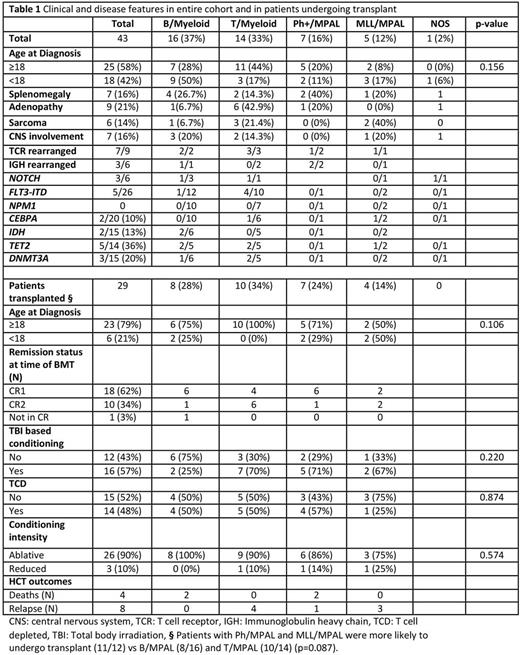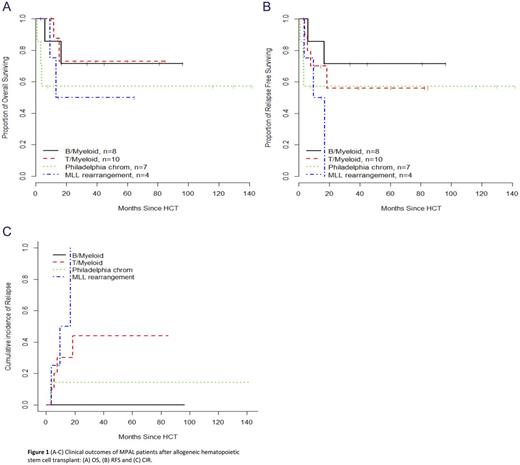Abstract
Aim: To investigate outcomes of allogeneic hematopoietic stem cell transplant (allo-HCT) in patients with mixed phenotype acute leukemia (MPAL) and to describe genomic profile of MPAL.
Methods: MPAL pts of all ages treated at out center (2002-2015) were included. Subtypes were classified based on the 2008 WHO Guidelines. Induction chemotherapy was categorized as ALL-type (N=10) defined by use ofasparaginase with corticosteroids (N=8) or hyper-CVAD (N=2) and AML-type defined by use of cytarabine andanthracycline withoutasparaginase, vincristine or steroids (N=33). Categorical variables were compared with Fishers exact test, overall survival (OS) and relapse free survival (RFS) with log-rank test/cox regression and cumulative incidence of relapse (CIR) with Greys test. Survivor curves were constructed with the Kaplan-Meier method.
Results: 43 pts were identified, 29 (67%) underwent allo-HCT. Diagnostic disease features are presented in table 1. MPAL groups included B/Myeloid (N=16), T/Myeloid (N=14),Ph+/MPAL (Philadelphia chromosome, N=7), MLL/MPAL (11q23 translocation, N=5) and MPAL NOS (N=1). MLL/MPAL clustered in pediatric pts (17% v 8%) andPh+/MPAL in adults (20% v 11%). Median follow up for survivors (N=31) was 42.1 months (95% CI 20.5-68.4) and median OS was not reached (95% CI 28.1-NR).
Cytogenetics wereavailable for 39 patients. 6 (15%) had a normal karyotype, 15 (38%) complex and 9 (23%) had a monosomal karyotype. The most common monosomywas -7 (n=6, 15%) and polysomywas +21 (N=5). Translocations were seen in 23 (59%) most commonly involving 14(q31-32) (N=5), This region was rearranged in cases of B or T/myeloid MPAL only. The region encodes several genes associated with B cell NHL (BCL11B, IGH) and T cell leukemia (TCL1A, TCL6).
Molecular typing was available in 26 (60%) patients and 9/26 (35%) had targetable mutations (FLT3, NOTCH, IDH or RAS). Most frequently mutated genes included NOTCH (3/6) seen in B and T/Myeloid MPAL and FLT3-ITD seen mostly in T/Myeloid MPAL (4/10). Mutations in IDH1 or IDH2 were seen only in B/Myeloid MPAL and no pts harbored mutant NPM1. Mutant TET2 (N=5/14) and DNMT3A (N=3/15) were seen only in adults and may represent underlying clonal hematopoiesis.
CR following first induction was achieved in 81% (35/43) with a similar rate in adult (21/25, 84%) and pediatric (14/18, 78%) pts. Similar high rates of CR were attained after ALL-type induction 8/10 (80%) and AML-type induction 27/33 (81%). In adults, CR was attained in 11/12 (92%) pts who received high dose cytarabine andmitoxantroneand in 5/7 (71%) with 7+3 (idarubicinordaunorubicin). In pediatric pts, CR was attained in 10/12 (83%) of those treated with DCTER and in 6/7 (86%) treated with a multi-agent pediatric ALLregimen. All pts withPh+/MPAL received induction chemotherapy (4 AML-type and 3 ALL-type) withimatinib(N=4) ordasatinib(N=3) and all achieved CR. All MLL/MPAL patients achieved CR after induction.
The median follow-up for transplant survivors was 45 months (95% CI 17.0-82.8) and median OS was not reached (95% CI 15.4-NR). Most adults (23/25 versus 6/18 in pediatric cases) and pts withPh/MPAL (7/7) and MLL/MPAL (4/5) underwent allo-HCT. Remission status at transplant, conditioning intensity and GVHD prophylaxis regimens were not different amongst MPAL types undergoing transplant (table 1). Relapse and OS after transplant were similar for pediatric and adult pts, and those receiving T cell depleted and conventional grafts. MLL/MPAL (p=0.031) and use of reduced intensity conditioning (p<0.001) were associated with higher cumulative incidence of relapse (table 2). In pediatric patients transplant was not associated with a survival benefit (p=0.183), while a potential benefit could not be assessed in adults as most underwent HCT.
Conclusion: MPAL is uncommon and lacks a standard treatment approach. Based on these data adults should receive induction chemotherapy with either high-dose cytarabine/mitoxantrone or 7+3 and undergo allo-HCT with ablative conditioning in CR1. The selection of pediatric patients who undergo allo-HCT is more complex due to the higher incidence of MLL/MPAL. MLL/MPAL may be associated with inferior transplant outcomes and should be a target for cellular and pharmacologic interventions following transplant. Extended genomic profiling in MPAL is recommended in all pts as 1/3 had potential targets for maintenance therapy following transplant.
Park:Baxalta: Consultancy; Amgen: Consultancy; Juno Therapeutics: Research Funding; Novartis: Consultancy. Stein:Novartis: Consultancy; Celgene: Other: Advisory Board, Research Funding; Agios Pharmaceuticals: Other: Advisory Board, Research Funding; Seattle Genetics: Research Funding. Roshal:BD Biosciences: Consultancy. Kernan:Gentium: Research Funding; The National Cancer Institute of the National Institutes of Health: Research Funding.
Author notes
Asterisk with author names denotes non-ASH members.




This feature is available to Subscribers Only
Sign In or Create an Account Close Modal